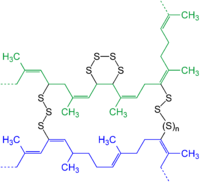
Photo from wikipedia
The formation of nanoaggregates makes a great difference to the improvement of photodynamic therapy (PDT) performance to some extent, but constructing stable aggregates with a clear structure is simultaneously a… Click to show full abstract
The formation of nanoaggregates makes a great difference to the improvement of photodynamic therapy (PDT) performance to some extent, but constructing stable aggregates with a clear structure is simultaneously a big challenge for us. Herein, just by electrostatic interaction, cationic 2PAHs and anionic FBA351, regarded as donor (D) and acceptor (A), respectively, are utilized to prepare stable aggregate of ionic-bonds coupled polymer (ICP) with repeated "D-A" structure, which is fully characterized by nuclear magnetic resonance (NMR), time-of-flight mass spectrometry, X-ray photoelectron spectroscopy (XPS), and scanning electron microscopy (SEM). Remarkably, aggregate ICP with multiple "D-A" structures showed enhanced photosensitization efficiency over its precursor 2PAHs and FBA351, which is in accord with the image-guided photodynamic anticancer therapy. Such results not only offer a simple way to obtain stable aggregate but also give us a guideline to design efficient photosensitizers.
Journal Title: Small
Year Published: 2023
Link to full text (if available)
Share on Social Media: Sign Up to like & get
recommendations!